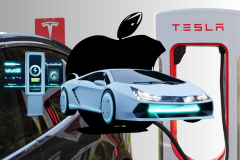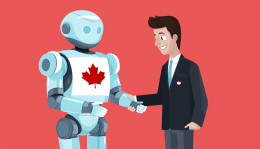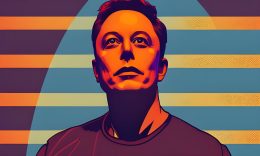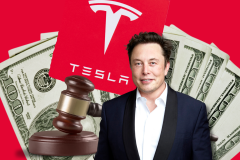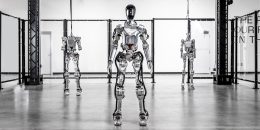Guest author Alex Salkever is head of product marketing and business development at Silk.co. This piece first appeared on his Tumblr.
Google announced that it is building 100 self-driving car prototypes that lack steering wheels, pedals or other troublesome mechanisms that humans might use to drive or steer a vehicle. It’s about time.
There’s a lot not to like about our current reliance on cars. The people who drive these one-ton machines are extremely dangerous and unpredictable: 34,000 souls lost their lives in car accidents in 2012 in the U.S. alone. We buy cars and use them hardly at all.
So what would a future without people driving or owning cars look like? Actually, I’ve been thinking about this for a little while. Take a ride with me into the future and you may not even need to fasten your seatbelt.
I’ll Have All This Room … In The Garage
In the year 2030, I will have a garage but it will be empty except for bicycles and other things. Or it might even be converted into a bedroom or an AirBnB rental unit. Likewise, there will be no car in my driveway. I will not need one as I will share a car with people in my neighborhood and use it only when needed, which is actually a very small percentage of my day.
Even more extreme, I won’t drive a car anymore. No one will, except for people undertaking the high risk hobby of race driving. Self-driving cars will have completely replaced the people-guided versions, saving tens of thousands of lives—or more—each year as a result. The cost of software and hardware to drive cars will have plunged to only a few thousands dollars per vehicle, down from nearly $200,000 in 2014. Drunk driving and pedestrian deaths due to driver error will cease to become serious societal problems.
Instead of wasting countless hours driving, I will be able to read, write articles, watch movies, or video chat with friends and family while in transit. I will order my self-driving car via my smartphone or a voice command to my wearable glasses. My son will dispatch his children to school, playdates and sports practices in a similar fashion. The fleets of self-driving cars will seamlessly integrate into delivery services that can drop off and pick up packages at any hour of the day or night (although deliveries will be concentrated in the evening hours.)
The money I would have spent on a car will go towards buying other things or maybe towards saving—something Americans don’t do enough of. And everyone will have access to this transportation service, even the poorest Americans. Rather than subsidize car insurance for low-income workers, the U.S. government will subsidize car service – something once considered a serious perk for Wall Streeters. Oh, the irony.
Take The A Train
But self-driving cars will actually feed demand for public transit. Subway riders will no longer need to find a parking space, pay for the space, or circle a parking lot looking for a space. Transit times will be faster. Out-of-pocket costs to get from Point A to Point B will actually be lower. Overall, we’ll save significant money and significant time in our daily lives.
At a societal level, self-driving cars will reduce traffic on city streets by roughly one-third and free up vast amounts of urban real estate currently dedicated to parking. Newer buildings in cities will accommodate 20% more people per square foot because they will not need parking spaces.
Reduced traffic will also mean reduced wear and tear on city streets. Police departments will no longer need to dedicate time and effort to traffic violations and speeding tickets. Traffic courts will disappear. Neighborhoods will be able to designate certain streets car and truck free for certain hours of the day, allowing children to play ball and ride bikes in the most dense urban zones.
For cars and trucks, the closures will matter little. The constantly updated turn-by-turn GPS navigation system maintained by Google, Microsoft and the U.S. government will update and optimize routing every few seconds.
Plunging battery prices will force car makers to remove the internal combustion engines as the old style of providing power to cars no longer is economically viable. This will also reduce carbon emissions. Asthma cases in cities and near freeways will fall dramatically, saving billions in annual medical costs and improving the lives and financial futures of millions of lower-income Americans.
Pipelines to transport gas and oil will lose their importance and go out of business. Transmitting electrons will be much easier, cheaper and environmentally friendly. Pipeline and oil tanker spills will end. Gas stations, tank farms, and other places where fuel is stored will no longer be needed near major urban areas. This will also reduce the number of toxic waste sites and improve air quality, aside from freeing up needed real estate.
Then There’s The Dark Side
That’s the utopian side. There is a darker side of a disruption that will dwarf the industrial revolution. The emergence of a true sharing economy for car and truck transportation will cause demand for autos to fall by 50% from peak levels. This will mirror the impact of cloud computing and virutalization on purchases of computing hardware and IT equipment.
Unfortunately, the reduced demand will bankrupt most of the major automobile companies, throwing scores of workers out of a job. Surviving auto and truck companies will decimate their workforces and shift to nearly 100% automated factories.
The huge chunk of the U.S. economy that depends on cars and trucks will also suffer a massive consolidation. Independent auto repair shops will disappear. So will car washes, auto detailing companies, and many other secondary vehicle services verticals. All car maintenance will shift to massive factory-like facilities where humans monitor machines but barely touch the cars themselves.
The multi-billion dollar after-market autoparts segment will shrink even more than the carmakers. Car owners are the dominant purchasing force in aftermarket car parts. If no one owns a car then no one will need to buy extra parts (except for the car fleet operators).
Airports will lose all parking revenue and will have to identify other means of revenue to replace this staple. Shipping companies such as UPS and Federal Express will be forced to compete with both automakers and the likes of Google. Automakers will allow third-parties to build delivery networks on top of shared self-driving cars. Google will use its maps and vast store of transportation information to allow anyone running an Android device to operate a regional or city-based delivery service that competes with the likes of FedEx or UPS.
While everyone will have access to cars, surge pricing and congestion pricing will become commonplace. Getting into the cities on weekends and during holidays will be very expensive. Government-funded hackers will spend even more time figuring out how to hack the transit infrastructure and bring the entire grid to a halt or worse—execute remote hijackings of cars or buses with people in them.
Cars will have advertising systems. For a reduced rate, we will agree to watch or listen to those ads that will make a detour to the donut shop or the movie theater a button push away.
The resource wars that once centered on oil and natural gas reserves will shift to focus on the limited amount of key elements required to make new types of long-lasting batteries. For example, the Andes and other places where lithium is found in abundance could become the New Middle East, with global factions vying for political control of the invaluable natural bounty.
As with any futurist predictions, your mileage may vary. And I am certain I will be wrong in many respects. But this future, as of today, looks a whole lot more possible than it did only a week ago.
Lead image courtesy of Google

